Discover the Unique Stories Behind America’s State Trees and Flowers Part 2: The Southeast
Introduction
The southeastern states of America have each picked unique flowers and trees to represent them. These plants tell us something about each state’s personality, history, and nature. From Alabama’s tall longleaf pine to West Virginia’s colorful rhododendron, these plants show how different the Southeast can be. They’re not just pretty—they’re also important to the people and places in these states. Some have represented their state for a long time, while others were chosen more recently. While these plants are symbols of pride, they can sometimes cause debates about what best represents a state. Follow along as we explore these state plants and learn why they matter to the Southeast.
ALABAMA
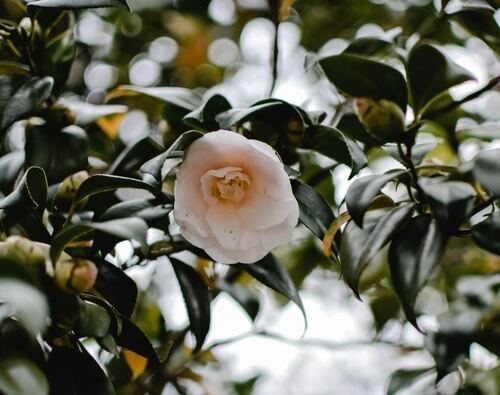
A White Camellia Flower – Photo by Eva Bronzini
Alabama’s state tree, the longleaf pine , is a special tree with some unique features, like how it grows. For the first five years of its life, the longleaf pine uses most of its energy to grow its roots. Because of this, above ground it just looks like a bunch of green needles, which makes it easily mistakable for grass. This “grass stage” is important because it helps the young tree to grow a strong foundation and be able to better resist fires, which are common where it grows. After this stage, the longleaf pine becomes very easy to spot. This is because it grows the longest needles of any kind of eastern pine tree. These needles can grow up to eighteen inches long! This creates a striking visual, showing where it gets its name. This combination of patient early growth and dramatic mature appearance reflects Alabama’s natural beauty and resilience. This makes it a fitting symbol for the state.
The camellia is Alabama’s state flower. It’s a striking evergreen shrub that adds a touch of elegance to the southern landscape. What’s special about it is when it blooms: While most plants flower in the spring and summer, the camellia blooms in the winter. This unique aspect helps it bring color and beauty to the landscape when most of the other plants are dormant. This makes it a beloved sight in Alabama’s winter gardens. Something interesting about this flower is that, even though it is very common in the southeastern United States and is important to the culture, it isn’t native to the region—it is actually from East Asia! People have grown it for a long time in Japan, China, and Korea. It was brought to the American South in the 1700s and became popular for its flowers and ability to thrive in the southern climate. Now, the camellia is so common in Alabama that many assume that it’s always been there. Its ability to adapt and bloom in the Alabama winter is a symbol of the state’s natural beauty and ability to adapt to new things. This makes it a good symbol for the wonderful state of Alabama.
ARKANSAS
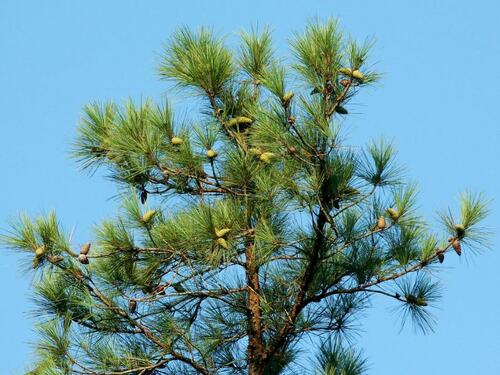
Green Pinecones Adorn a Loblolly Pine – Image by JamesDeMers from Pixabay
The loblolly pine, Arkansas’s state tree, is a unique tree that grows in wet, swampy areas. This tree loves swampy spots so much that its name means “muddy puddle.” You can easily spot this tree by looking out for its tall, straight trunk and reddish-brown bark, which grows in broad plates like a jigsaw puzzle. It also has pale-green needles that look almost like feathers against its sturdy trunk. Next time you’re trudging through a marshy area, keep an eye out for this resilient beauty. The loblolly pine is living proof that thriving in challenging conditions can make you truly remarkable.
The apple blossom was crowned as Arkansas’s state flower in 1901. This flower is very important to the state’s history. Back in the day, Arkansas was one of the biggest producers of apples in the country. This is especially true in the northwest, where apple orchards were found all over the area. These delicate pink-and-white flowers weren’t just pretty—they were the promise of a bountiful harvest to come. They also have a wonderful, fragrant smell. In early spring, they would cover the hillsides with soft colors, announcing the coming of warmer weather and harvests to come. Even though Arkansas isn’t the apple capital it used to be, the apple blossom remains a beloved symbol of the state’s roots. In Arkansas, it isn’t just a flower—it’s a piece of history that blooms again every spring.
FLORIDA
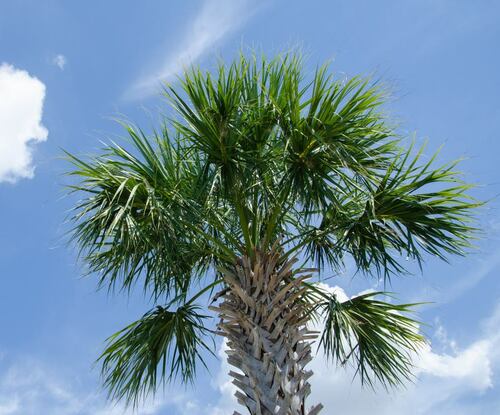
A Sabal Palm Against a Blue Sky
Florida’s state tree, the sabal palm, is an iconic symbol of the state’s lush subtropical environment. Standing up to eighty feet tall, it has a slender trunk and graceful fronds that fan out from its crown, creating a striking profile against the sky. Besides its beauty, the sabal palm is known for its strength . For example, it can handle Florida’s hurricanes and other bad weather. These trees have been a part of Florida’s habitat for hundreds of years, reflecting the state’s deep connection to its tropical history.
The orange blossom has been Florida’s state flower since 1909. This dainty white flower adorns the orange trees that dot Florida’s landscape, filling the air with a sweet, citrusy scent during their blooming season. Beekeepers will often bring in hives to pollinate the flowers. This creates a citrus-flavored orange blossom honey! The orange blossom is more than just a pretty sight, though. It serves as a reminder of Florida’s once-thriving citrus industry. This flower continues to be loved by the people of Florida for its beauty and importance to the Sunshine State.
GEORGIA
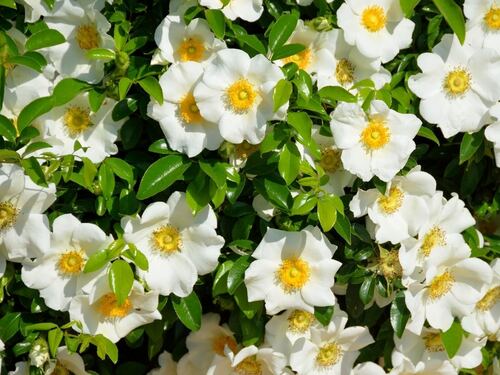
Cherokee Roses Growing on a Bush – Image by Paul Brennan from Pixabay
The live oak, Georgia’s state tree, stands as a majestic and iconic symbol of the American South. What makes this tree truly special is its unique growth pattern. Starting from the trunk, the branches grow upward before gracefully arching downward, sometimes even touching the ground. This creates a natural canopy that seems to cradle the earth. But it doesn’t stop there—its branches then sweep up once more, forming a broad, sprawling canopy that can reach up to 150 feet in diameter. This growth not only provides lots of shade but also shows off the tree’s strength and ability to adapt—qualities that are deeply rooted in Georgia’s spirit. Some of these respectable oaks have stood for over a millennium, serving as long-standing testaments to the state’s rich history and natural legacy.
The Cherokee rose has an interesting story. This beautiful white flower was chosen to be Georgia’s state flower in 1916. It came to America from East Asia in the 1700s. Surprisingly, it became deeply linked to the Cherokee people and their stories. The five petals around its golden center came to represent the tears of Cherokee women during the Trail of Tears. The flower’s toughness and beauty, along with this touching meaning, made it an important part of Georgia’s culture. The Cherokee rose shows us how nature, history, and human lives can mix in unexpected ways, creating symbols that really matter to people.
KENTUCKY
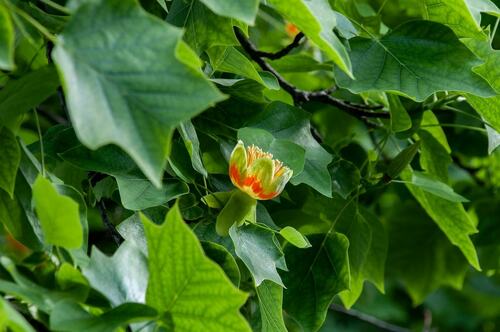
A Tulip Poplar Flower Among Green Leaves – Image by wal_172619 on Pixabay
Kentucky’s state tree, the tulip poplar, is a true giant of the forest. Despite its name, this impressive species is a type of magnolia instead of a poplar. This fast-growing tree can reach impressive heights of up to 150 feet. This makes it one of the tallest eastern North American hardwoods. The tree earns its name from its yellow-green flowers with a splash of orange that look a lot like tulips. These flowers usually bloom in late spring. They aren’t for show, though; they’re an important source of nectar for bees and hummingbirds. The tulip poplar’s uniquely shaped leaves, which have four lobes and flat tops, turn a beautiful golden yellow in the fall. This creates a stunning sight across the state. Its straight, clean trunk made it a prized timber tree throughout history; it was used for everything from canoes to fine furniture. It’s still an important source of timber even today! With its blend of beauty, its importance to the environment, and its practical value, the tulip poplar embodies Kentucky’s natural beauty and its deep-rooted forestry traditions, making it a fitting symbol for the Bluegrass State.
Kentucky’s state flower, the goldenrod , adds a splash of golden color to the state during the summer and fall. This tough plant can grow up to seven feet in height! You can identify this plant by its long, arching stem decorated with clusters of tiny, bright-yellow flowers. These showy plumes are not only pretty but also provide an important late-season source of nectar for pollinators like bees and butterflies. Despite its beauty, many people believe goldenrod causes hay fever. This isn’t true, however, as its pollen is too heavy to be carried by the wind. This plant is native to North America and can grow in many places like fields, prairies, and nearby forests, showing how tough and adaptable this plant is. Chosen as the state flower in 1926, the giant goldenrod is a symbol of Kentucky’s natural beauty and strength. There’s more to this golden giant than meets the eye—historically, it’s been used for medicine and dyes. In essence, the giant goldenrod embodies the spirit of Kentucky: Hardy, versatile, and undeniably beautiful.
LOUISIANA

A Large Magnolia Flower – Image by J from Pixabay
Louisiana’s state tree, the bald cypress, is a true champion of the swamps. This tree is well-suited for Louisiana’s landscape. One of its special features is its well-known resistance to rot. Because of this, many people like to use its wood for building everything from fence posts to boats and other things where its resistance to decay is essential. What really sets the bald cypress apart are its “knees,” or the curious protrusions that emerge from the water or soil around the tree in swampy areas. These “knees” help the tree thrive in the wetlands. With these unique features and this adaptability, the bald cypress is a fitting symbol of Louisiana’s rich, diverse habitats. It doesn’t just survive in the swamps—it thrives, making it a true icon of the Bayou State.
The southern magnolia is Louisiana’s state flower, embodying the grace and beauty of the state. This tree is from the southeastern United States. It’s well known for its big, sweet-smelling white flowers, which can be up to twelve inches wide! These flowers bloom in late spring and appear into summer. During this time, they fill the air with their sweet, lemony scent. The magnolia’s thick, glossy leaves are dark green on top with a rusty brown underside, serving as a backdrop for the striking flowers. In Louisiana’s steamy climate, Magnolia trees can grow up to sixty to eighty feet tall, offering shade to people and homes to wildlife. Its wood is also prized for its strength and beauty. Various parts of this tree have also found their way into traditional medicine! This tree’s significant presence often symbolizes enduring strength and beauty in Southern literature and culture. Chosen as the state flower in 1900, this magnificent tree embodies the essence of the south—strong, beautiful, and deeply rooted in history and culture. It’s a living symbol of Louisiana’s natural history and its unbreakable bond with the Southern way of life.
MISSISSIPPI
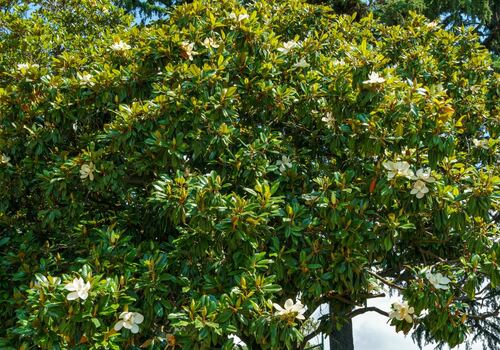
A Lush Green Magnolia Tree with White Blooms
The magnolia is both the state flower and tree of mississippi. This tree is a symbol of Southern charm and the state’s natural beauty. It’s known for its large, fragrant white blossoms and glossy green evergreen leaves. These stunning trees are a common sight across Mississippi and represent the South’s friendly spirit. The Magnolia’s flowers usually bloom in late spring and early summer. During this time, these flowers fill the air with a lemony scent. Magnolias are sturdy and can live long lives, often becoming the main attraction in parks and gardens because of their grand size. The tree’s importance to Mississippi runs so deep that the state is nicknamed the “Magnolia State.” You can even spot the flower on the state flag! It’s clear that the magnolia isn’t just a tree—it’s a beloved emblem of Mississippi’s natural beauty and heritage.
VIRGINIA

Dogwood Flowers on a Branch – Photo by Taylor Smith on Unsplash
The flowering dogwood is a beautiful and versatile tree; it’s no wonder that it has the honor of being both the state tree and the state flower of Virginia! This tree is so beloved that it is also the state tree of Missouri and New Jersey and the state flower of North Carolina. One of the dogwood’s special features is its bark—the gray bark cracks into small, broken squares as the tree gets older. This texture makes it look almost like alligator skin. This makes dogwood trees fun to look at even when they aren’t in bloom. The flowering dogwood’s most famous feature is its showy spring flowers, though. These “flowers” have a secret—their petals are actually modified leaves! These leaves are called “bracts” and are meant to protect the tiny flowers in the center of the “flower.” Flowering dogwoods are not only beautiful but also useful. Their wood is very strong, making it good for making sturdy things like tool handles and arrows. This combination of beauty and usefulness makes the flowering dogwood a good symbol for Virginia, representing these same qualities in its people and its environment.
TENNESSEE
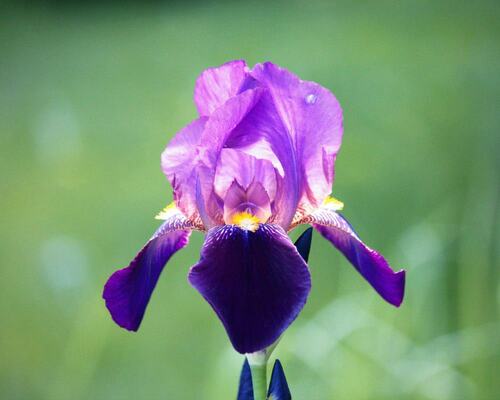
A Gorgeous Purple Iris Flower – Photo by Lana Svet on Unsplash
The tulip poplar , Tennessee’s state tree, was chosen for its presence “from one end of the state to the other.” This shows just how adaptable this tree is to Tennessee’s range of landscapes. This tree, often reaching over one hundred feet, was crucial to early settlers, who used its wood to build homes and barns. Its name comes from its large, tulip-shaped flowers that bloom in late spring. These flowers are usually a greenish-yellow color with orange bands. But they can also be yellow or pink, attracting bees and pollinators. The tulip poplar’s widespread presence, historical importance, and beautiful flowers make it a fitting symbol for Tennessee. It represents the state’s natural beauty, the resourcefulness of its early settlers, and the ongoing connection between the people and their land.
The iris became Tennessee’s official state flower in 1933. It was chosen for its beauty and bright colors that decorate the state. However, its story as the state flower is not a simple one. The iris actually was not the first choice—earlier, schoolchildren had picked the passionflower as the state flower. In 1973, the state made it clear that the iris was specifically the “official cultivated flower,” showing how important it is in both gardens and in the wild. With its striking purple blooms (though irises can also come in other colors), it has become a cherished symbol of Tennessee’s natural splendor and gardening heritage.
NORTH CAROLINA

A Sunlit Pine Tree – Photo by Aravind Pasupathi on Unsplash
North Carolina’s state tree isn’t just one kind of pine—it’s all of them! This broad designation encompasses several species of pine native to the state, like the loblolly pine, longleaf pine, and shortleaf pine. Pines are evergreen conifers that dominate many of North Carolina’s forests, especially in the eastern part of the state. These trees are known for their tall, straight trunks, needle-like leaves, and distinctive cones. These trees are highly important to North Carolina. In the past, people used pine wood to build ships and houses. Even today, pine trees are a big part of the state’s forestry business. They also provide important habitats for wildlife. By choosing the pine as its state tree, North Carolina shows how one type of tree can be important in many ways—in nature, in business, and to the state’s history. It reminds us that the forests are a big part of what makes North Carolina special.
North Carolina’s state flower, the flowering dogwood, is a sure sign that spring has arrived. This small tree puts on a beautiful show in April, with its showy white or pink “petals” (called bracts) surrounding tiny greenish-yellow flowers. The dogwood blooming is so loved that there are festivals celebrating it across North Carolina! These festivals have become yearly traditions, bringing people together to enjoy the blooms and celebrate the new season. With parades, craft shows, music, and more, these events show how important the dogwood is to North Carolina’s culture. It’s a beloved part of springtime that brings joy to communities across the state.
SOUTH CAROLINA

Leaves and Flowers of Yellow Jessamine
The sabal palmetto has been the state tree of South Carolina since 1939. It is also called the “cabbage palm.” It’s famous for its role in the American Revolution. In 1776, the trunks of these trees were used to build Fort Moultrie. The spongy wood from these trees absorbed British cannonballs instead of breaking. This helped Americans to win the Battle of Sullivan’s Island on June 28, 1776. This victory made the palmetto a symbol of South Carolina’s strength. The sabal palmetto can also be seen on the state flag, showing how important it is to the state. Besides how important it is in history, this tree also grows well near the coast. It can handle the salty air and strong winds well with its fan-shaped leaves and tall trunk. This makes it a common and beautiful sight along South Carolina’s coastline. The sabal palmetto embodies both the state’s natural beauty and patriotic pride, making it a good symbol to represent South Carolina.
The yellow jessamine has been South Carolina’s state flower since 1929. It is also called “Carolina jasmine.” This evergreen vine is native to the southeastern United States. It was chosen as the state flower because of how common it is across the state as well as what it signifies. The delicate trumpet-shaped flowers bloom toward the end of winter, from February to April, showing the world that spring is on its way! This early blooming makes it a welcome sight for the people of South Carolina after the cold winter months. The flower is not only beautiful but also has a sweet scent as it climbs trees and fences throughout the state. The yellow jessamine wasn’t picked just for its beauty, however; it also holds a special meaning. Its gold color is said to represent the state’s natural beauty and character. Its return every spring shows how loyal and patriotic South Carolina’s people are. But be careful—while these flowers are beautiful, all parts of them are poisonous if eaten. This reminds us that sometimes beauty needs to be admired with caution.
WEST VIRGINIA

Rhododendron Flowers on a Mountainside – Photo by Ciocan Ciprian on Unsplash
The sugar maple , West Virginia’s state tree, is an amazing tree that can live up to three hundred years. It isn’t very tall, only reaching up to about sixty to seventy-five feet in height. But it has a very dense, broad canopy that can support many kinds of wildlife. Its long life and adaptability have made it a resilient fixture in West Virginia’s changing landscape. Sugar maples are most famous for making sap for maple syrup. In early spring, temperature fluctuations cause sap tso flow, which is then tapped and boiled down. This process showcases the sugar maple’s unique biology and importance to the culture of West Virginia.
The rhododendron, West Virginia’s state flower since 1903, is a plant of contrasts. It’s a tough, beautiful shrub that thrives in the Appalachian Mountains. The great rhododendron grows well in the state’s forests, sometimes forming thick patches in shady areas. Its big, waxy leaves stay green all year, and in late spring or early summer, it puts on a show with clusters of pink or white flowers. While pretty to look at and able to handle harsh mountain weather, the rhododendron has a hidden danger—all parts of it are extremely toxic if eaten by humans. It does have its benefits though, providing homes and food for some wildlife. This mix of beauty, toughness, and toxicity makes the rhododendron an interesting but complex symbol for West Virginia.
In Conclusion
The state flowers and trees of the Southeast are meaningful symbols that represent each state’s identity, beauty, and culture. These plants highlight the region’s diverse ecosystems and the connection between nature and people. They serve as reminders of the importance of conversation and encourage state pride. They represent the Southeast’s natural beauty, culture, and the bond between its people and the land they call home. What are your stories and experiences with these plants? Whether it’s a childhood memory of picking your state flower, a family tradition involving your state tree, or a personal connection to these natural symbols, your stories help keep these traditions alive and deepen our collective appreciation for the Southeast’s natural history.
Did you miss Part One of our State Trees & Flowers series? Check it out here! And don’t miss the rest of this blog series:


